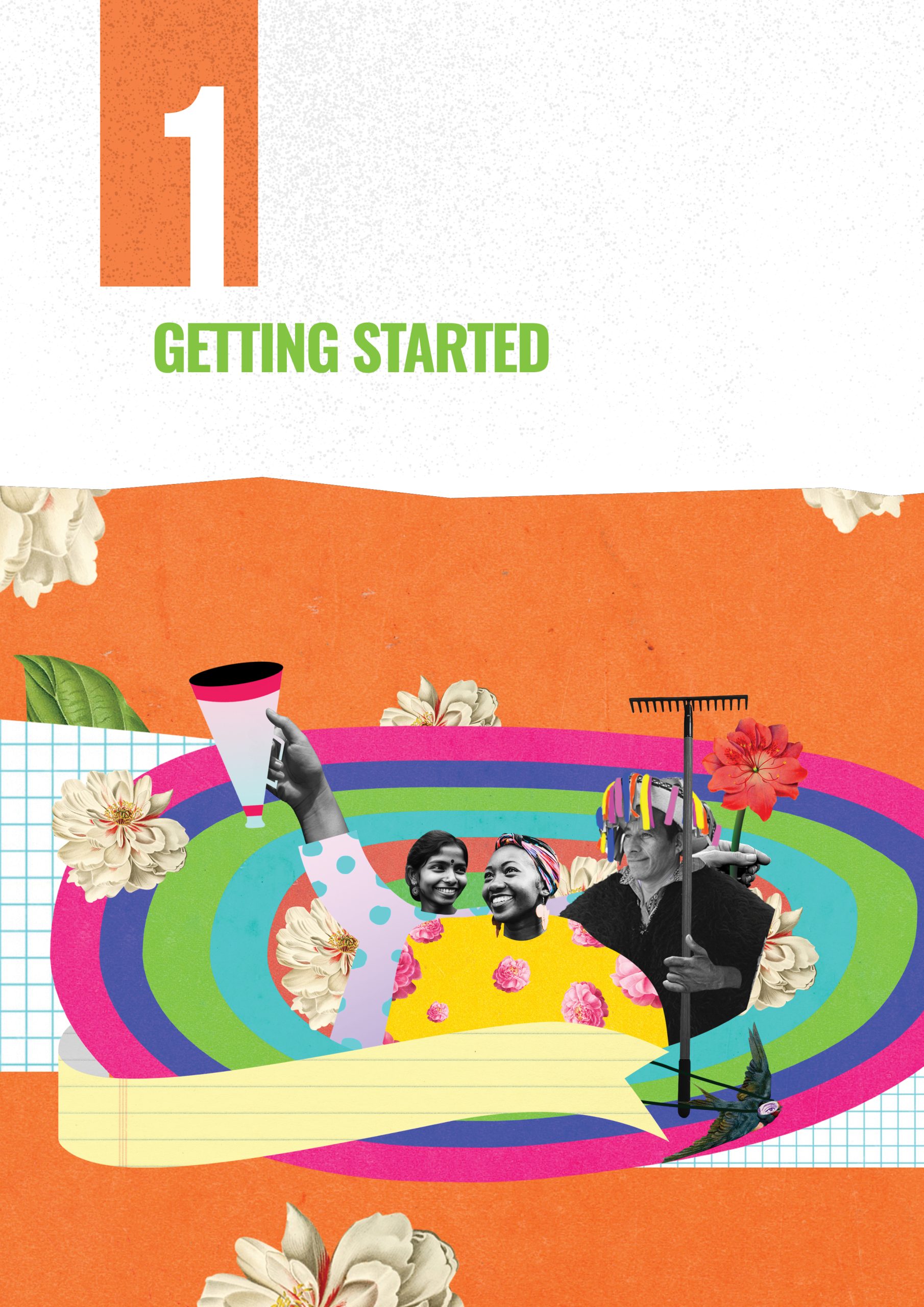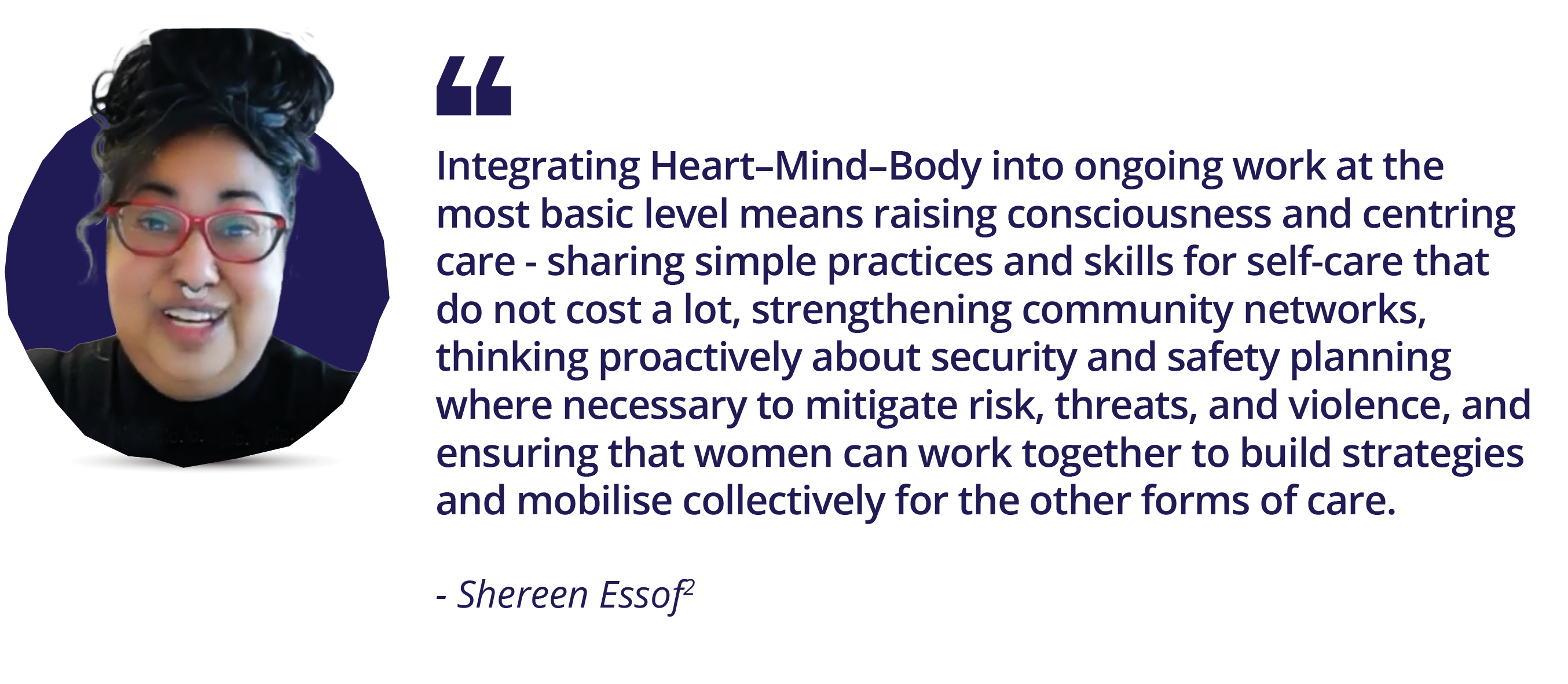Chapter 1: Getting Started

Download this chapter A4 size or Letter size.

A key starting point for this Guide’s power journey is to ground ourselves in both who we are and what we want. We take time to envision the future we want to create, as it is the driving logic, the ‘why’, that shapes our social justice efforts. From experience and evidence, we know that to make systemic change we must build movements – the networks and communities, both physical and virtual, that advance our agenda to make a better world possible for everyone. Within our movements, we can:
- Learn, collaborate, and take action together.
- Create a sense of belonging and believing.
- Embody our principles in the ways that we organise and lead.
In order to use the Guide most effectively, it is important that we locate ourselves and our organisations in relation to the issues, power dynamics, politics, and movements of our context. We situate ourselves in a larger ecosystem of social justice to which we want to connect. There are many ways to contribute to change, and it is vital that we each know what we have to offer and how that could complement the work of others.
Because this Guide is at its heart about creating transformational change, it centres questions of power and strategy, looking at them from a variety of angles, and offering practical and conceptual resources for activists and changemakers of all kinds. Here and throughout this Guide, our approach is Feminist Popular Education. As a political methodology, FPE guides people – individually and within communities and organisations – to recognise and share their experience and knowledge, build connections and common purpose with others and activate their collective power for change. Across the Guide, we begin with individual reflection and build toward shared understandings and analysis that focus and inform collective strategies.
Safe and brave spaces
We begin any process by creating a safe and brave space – one that is collectively defined and maintained by the group working together – to enable everyone to bring their ‘full selves’ (heart, mind, and body) without having to filter what they say. Because the jumping off point for feminist popular education is people’s experiences – with power, inequity, and oppression – the process can surface emotion. A safe and brave space is one that honours that emotion, recognising that much untapped power lies in breaking silence and finding common cause with others, and helps the group move toward action. Another aspect of safe space is that our activism can put us at risk – we must make sure that in designing safe spaces we think about this and put in place strategies to mitigate threats. Other considerations in creating safe and brave space include: the security of the location; collectively created ground rules including on consent for photos and social media sharing; language and other forms of accessibility; the feel, look and comfort of the space; the availability of smaller group breakout areas; and the level of care and trust needed. For more, see We Rise on Creating Safe Space.The intention of a safe space is to create the conditions for courage – courage to break silences, courage to share life experiences so we can find common ground, courage to seek common purpose with others different than yourself, courage to imagine and act for change. It is the combination of safety and courage in a group that can unleash power for transformative change.
Remember that:
- Participation is optional – anyone can step out any time.
- People should share only what they choose to.
- Difficult issues may emerge, such as experiences of violence, fear, or discrimination, when it’s important to pause.
The Politics of Heart–Mind–Body
 This Guide engages the question of power and change from a decolonial feminist and movement building perspective. A critical dimension of this approach is the value placed on the many forms of knowledge that come from life experiences and are carried in our hearts, minds, and bodies. Our commitment to what we call “Heart-Mind-Body” reflects a belief that, without such a holistic approach, we will not only miss key insights but also risk creating fragmented strategies that only speak to one part of our lives. The activities in this Guide engage multiple forms of learning in keeping with this political orientation.
This Guide engages the question of power and change from a decolonial feminist and movement building perspective. A critical dimension of this approach is the value placed on the many forms of knowledge that come from life experiences and are carried in our hearts, minds, and bodies. Our commitment to what we call “Heart-Mind-Body” reflects a belief that, without such a holistic approach, we will not only miss key insights but also risk creating fragmented strategies that only speak to one part of our lives. The activities in this Guide engage multiple forms of learning in keeping with this political orientation.
- Some activities, such as “Rivers of Life” and “Body Mapping”, involve storytelling and deepen people’s understanding of the realities of each other’s lives, an important building block for trust and joint action. They can also surface uncomfortable memories – so be prepared to offer some support in the moment. You might bring the group together to stand or hold hands in solidarity, take time for collective centring and breathwork, or offer other forms of culturally appropriate emotional support. Empathy and care are fundamentally important in creating spaces for learning. And in case more is needed, you may want to have links to resources and contacts with support networks such as counselling, medical, and legal services.
Theme 1: Starting with Ourselves
How can we create knowledge together from our experience and the information we gather around us? How do we integrate what we know in our hearts, minds, and bodies? How have our lived experiences shaped who we are as activists and change makers, beyond our formal education? And how can greater critical awareness about how what we learned has shaped us, enable us to engage with others in more intentional, liberated, and liberating ways?
Theme 2: Reimagining the Future
What is the future we dream of and work toward? What values and beliefs guide our ways of working? How will we move toward the future?
Theme 3: Roadmaps to Change
As we imagine the path toward our vision, what hurdles and twists do we foresee? What are our assumptions about how change happens and how people change? How do we understand movements and movement building?
Theme 4: Who are ‘We’?
How do we situate ourselves in the larger ecosystem of movements for justice? What do we stand for? What do we bring and offer? Where do we have access and relationships, and where not?
______________________________________________________________________________
1 African American writer, educator and spoken word artist.
2 JASS Executive Director
